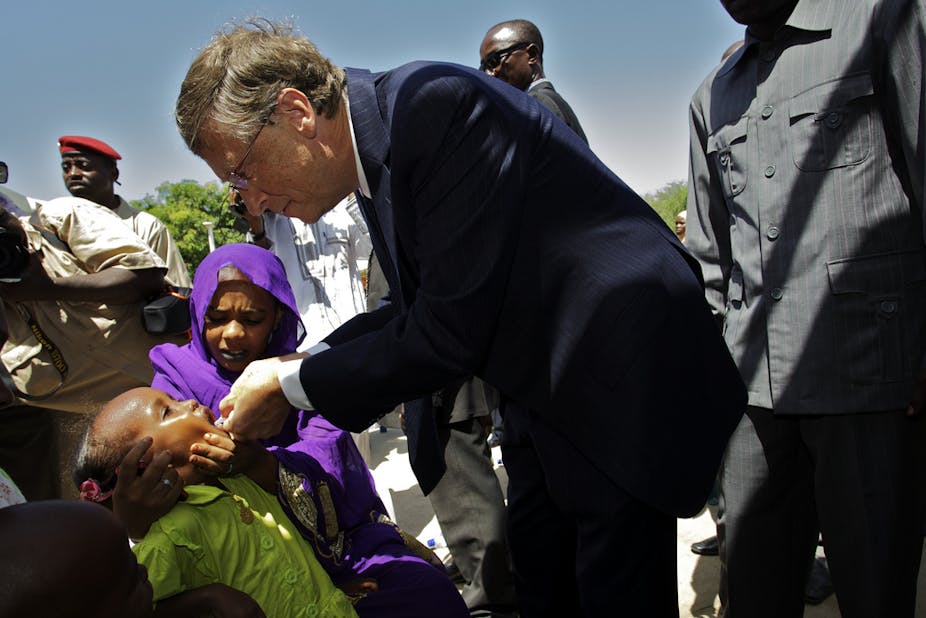In the Bill and Melinda Gates Foundation annual letter, published recently, Bill Gates declared “by 2035, there will be almost no poor countries left in the world”. Pointing to the fact that during the past 50 years, many of those countries once deemed to be “poor” now have thriving economies, Gates suggests that the myth that these countries are destined to remain poor is simply not true. Africa, he argues, has seen incomes rise over the past half century, and significant gains made in health and education.
Leaving aside his assertion that the myth of predetermined and eternal poverty of poor countries enjoys wide currency (really?), is there anything in Gates’ optimistic assertion that things can only get better?
There are two ways of thinking about poverty. The first is to focus on a threshold, below which one is poor, and above which one is not. By using the World Bank’s categorisation of countries by income, Gates falls firmly into this camp.
At the individual level, extreme poverty refers to the inability of the individual to be able to secure the basic minimal requirements humans need (food, shelter, health, clothing, and so on). Most frequently this is translated into an income per day.
The UN’s Millennium Development Goal for eradicating extreme poverty uses the World Bank’s figure of US$1.25 as the cut-off point. Of course, what $1.25 will buy in one country may be very different from another, so estimates also try to take this into account (through a model known as “purchasing power parity”, in other words, what your $1.25 will get you).
But Gates is writing about the national level, and there we talk about low and middle-income countries. A low-income (or “poor”) country is one in which gross national income (GNI) per capita is less than US$1,035.
Clearly, if we are to use a threshold approach, Gates is right – if optimistic. If economic growth can be maintained in sub-Saharan Africa, most of the low-income countries may indeed become middle-income in the next 20 years.
Most countries in East Africa, for example, are on course to reach middle-income status by 2020 and the UN has predicted most of the continent will reach the threshold by 2040. Indeed, 22 African countries are already classed as “middle-income”, including Ghana and Zambia who recently joined the club.
But of course, even if middle-income is not poor (by threshold definitions), it is nonetheless very much at the lower end of the spectrum. After all, $1,036 per annum works out at just $2.80 per day. And inequality within MICs means that while many may have joined a notional “middle class” there will still be millions who remain in poverty.
So ending poverty at the national level does not end the poverty of people. The key question we need to then ask is, if most African countries will indeed reach middle-income status, how can that national gain be translated into economic growth that benefits an entire population. This is a far more tricky problem and one to which the international development architecture has yet to find a convincing and sustainable answer.
The second way of looking at poverty is to think of it in relative terms. In other words people can be poor relative to others in their community or country and cannot meet the normal prevailing living standards. Again, income often stands in as an (imperfect) proxy. For instance, within the European Union, those living on less than 60% of the median income are defined as “poor”.
This kind of poverty is much harder to eradicate than extreme poverty, reflecting as it does profound inequalities within societies, in which the rich are the main beneficiaries of growth and use their status and power to maintain their dominance over economic gains.
Some may ask whether this matters. If all can gain the basic essentials and, increasingly, the other elements for a decent life, does relative poverty matter? The answer is yes, and not just from a moral standpoint.
Inequality matters because the poor are more likely to die earlier, more likely to be the victims of crime, more likely to have lowered educational outcomes and so on. Relative poverty affects the opportunities available to individuals, and in turn that can make it harder for subsequent generations to escape their circumstances, despite their potential.
As relative poverty is reliant on the same inequalities created by a system that has served global corporations such as Microsoft so well, ending it will be much harder. This is certainly not a target that will be achieved by 2025, 2050 or probably even 2100.
Given that, it would be easy to dismiss Gates’ vision as another optimistic, but ultimately unrealisable aspiration. Indeed, promises that poverty would be ended within a decade, within 15 years, within 20, 30 or more years, have sustained international development since the mid-1940s. Don’t forget, the first Decade of Development was announced by President Kennedy back in 1961.
But there is another, more hopeful, way to read Gates’ letter. Not to see 2035 as an achievable goal, but as a challenge: a challenge to governments, to international organisations, to donors, to philanthropists, to development organisations, and to ourselves.
By working to end absolute poverty, by helping governments move towards middle-income status, we do so not with the belief that this will end poverty, but so that it will push for greater action on addressing all forms of poverty.
The end point should not be 2035 – but focusing on it can, and should be, the means through which economic gains are translated into greater equality, and declining poverty for all.

